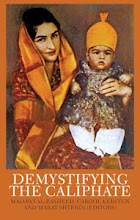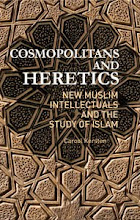
Abdurrahman Wahid, affectionately known as Gus Dur, has died at the age of 69 in the Indonesian capital Jakarta.
 The first freely elected head of state of the Indonesian republic after the fall of the Soeharto regime, Gus Dur's term in office (1999-2001) was troublesome and cut short by impeachment procedures which saw him replaced by Vice-President Megawati Sukarnoputri, the daughter of the country's founding father, Soekarno.
The first freely elected head of state of the Indonesian republic after the fall of the Soeharto regime, Gus Dur's term in office (1999-2001) was troublesome and cut short by impeachment procedures which saw him replaced by Vice-President Megawati Sukarnoputri, the daughter of the country's founding father, Soekarno.His legacy as a Muslim reformist, however, will outlast the sad demise of his short-lived political career. Together with Nurcholish Madjid he was the face of the liberal and pluralist Islam which emerged in Indonesia during the last three decades of the 20th century.
Born in the East-Javanese district of Jombang, Abdurrahman Wahid was the grandson K.H. Hasjim Asj'ari (1875-1947), a prominent Muslim scholar and founder of the Nahdlatul Ulama (NU). Now one of the largest Muslim organisations in the world (it claims a following of over 30 million), the NU has for decades represented the traditionalist Muslim establishment; the gurus or kyai whose bases of power were the Islamic boarding schools known as pesantrens found throughout rural Java. Hasjim Asj'ari's son -- and Gus Dur's father -- K.H. Wahid Hasjim served as the first Minister or Religious Affairs (1945, and again 1949-52) and succeeded as NU leader in 1947, until his untimely death in 1953.
After receiving both a secular and traditional Islamic education in Jakarta, Yogyakarta, Jombang, and Magelang Gus Dur worked as a teacher at a modernist Islamic school (madrasa) affiliated with Pesantren Tambakberas and as a journalist.
In 1953, he was awarded a scholarship for study at Cairo's al-Azhar University. Forced to take remedial classes in Arabic before attending the university's Higher Institute of Islamic and Arabic Studies, Gus Dur preferred spending his time reading world literature, watching European and American movies, and football. Bored with the curriculum at al-Azhar, Gus Dur opted for a transfer to the University of Baghdad, where he studied Arabic literature. Leaving Iraq in 1970, he made a failed bid to enter Leiden University in the Netherlands and then decided to travel home via France and Germany.
Back in Indonesia, Gus Dur joined the Institute for Economic and Social Research, Education and Information, also known under the acronym LP3ES . In addition he became a journalist, working for periodicals such as Prisma, Tempo and Kompas, and returning to Pesantren Tambakberas as a teacher.
As a descendant from an elite NU family, Abdurahman Wahid also become involved in the Pesantren reform policies initiated by Minister of Religious Affairs, Abdul Mukti Ali (1971-78), which he supported enthusiastically. These Islamic schools would provide the seedbed for the new Muslim intelligentsia emerging in the course of the 1980s and 1990s, which formed the constituency for the alternative Islamic discourse referred to as Islam Kultural (Cultural Islam) or Islam Sipil (Civil Islam), and for which Gus Dur himself coined the term Islam Kosmopolitan (Cosmopolitan Islam).
More interested in working as a public intellectual and writer than an organisational and administrative career, Gus Dur was very reluctant to become involved in NU affairs and only after a third appeal from his maternal grandfather Bisri Syansuri did he accept a place on the NU religious advisory council.
From this position he began to challenge the existing NU leadership which he held responsible for the organisation's rampant stagnation. Gus Dur proposed not only drastic internal reforms but withdrew the NU also from party politics, severing its links with the United Development Party (Partai Persatuan Pembangunan or PPP). His successful proposals for revitalising the stale NU made him very popular and in 1984 he followed in his father and grandfather's footsteps by being elected chairman of the NU -- a post he would continue to hold until 1998.
 During those fifteen years, Gus Dur groomed a new generation of NU intellectuals, which came to be known as the NU Muda or 'Young NU Members'. Educated at reformed pesantrens, many went on to study at the State Institutes of Islamic Studies (IAIN) found in cities such as Jakarta, Yogyakarta, Surabaya, and Bandung. The most talented would subsequently be given the opportunity to pursue postgraduate studies at universities in North America (in particular McGill University in Canada), Europe and Australia. Combining intimate familiarity with the Islamic tradition with knowledge of the latest advances of Western scholarship in the humanities and social sciences, they are now making their own contributions to the formulation of alternative Islamic discourses through a critical engagement with the Islamic heritage, informed by the cosmopolitan outlook they have acquired through their exposure to a wide array of intellectual influences. For more on this, read the article Indonesia's New Muslim Intellectuals in Religion Compass.
During those fifteen years, Gus Dur groomed a new generation of NU intellectuals, which came to be known as the NU Muda or 'Young NU Members'. Educated at reformed pesantrens, many went on to study at the State Institutes of Islamic Studies (IAIN) found in cities such as Jakarta, Yogyakarta, Surabaya, and Bandung. The most talented would subsequently be given the opportunity to pursue postgraduate studies at universities in North America (in particular McGill University in Canada), Europe and Australia. Combining intimate familiarity with the Islamic tradition with knowledge of the latest advances of Western scholarship in the humanities and social sciences, they are now making their own contributions to the formulation of alternative Islamic discourses through a critical engagement with the Islamic heritage, informed by the cosmopolitan outlook they have acquired through their exposure to a wide array of intellectual influences. For more on this, read the article Indonesia's New Muslim Intellectuals in Religion Compass. After leaving office, Gus Dur concentrated his efforts on promoting his own pluralist interpretation of Islam's civilisational legacy through lectures, publications and a think tank called the Wahid Institute.
After leaving office, Gus Dur concentrated his efforts on promoting his own pluralist interpretation of Islam's civilisational legacy through lectures, publications and a think tank called the Wahid Institute.
Abdurrahman al-Dakhil Wahid was buried near his father and grandfather's shrines in his hometown Tebuireng, dstrict Jombang, with President Susilo Bambang Yudhoyono presiding at the funeral ceremony.














